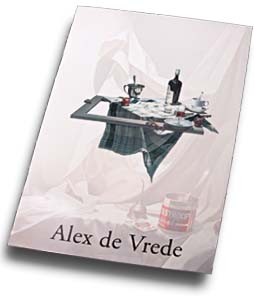Alex de Vrede

|
|
This catalogue has been published at the occasion of Alex de Vrede's solo
exhibition, 19 May - 23 June 2001, and is compiled and written by Koen
Nieuwendijk. (16 pages, 19 full colour reproductions, ISBN 90-70-402-14-9)
The Ideal Misconstruction Jotting down that De Vrede's name means "peace", the thought came to me in a blinding flash that I was writing in Dutch while thinking in English. I wonder whether one could describe this as a case of "trompe-d'oreille mentale". Of course no self-respecting Dutchman or woman wants to know about the risk that a hundred years from now the Dutch language will have come to occupy a similar position as the Frisian language does today, but even if you are an anti-€pean Union crusader I cannot believe that at some level of consciousness or other you will not gear yourself to the processes of sweeping change which have thus been unleashed. I do believe, however, that the unsettling impact of Alex de Vrede's trompe-l'oeuil works is partly to blame for confusing trains of thought such as the above. Evidently this forms part of a matter-of-fact process: for some reason or other people are tremendously attracted to displays of visual deception, no matter how eager we are otherwise to face the real world. Hoodwinking one's audience is permitted in paintings. A Lamp as Source of Inspiration Let's imagine that we are in Alex de Vrede's studio, trying to figure out what is going through his mind. Here one senses the delicate balance with which the objects in the paintings have been captured to an even greater degree. Wires running up to the ceiling and to the walls and surrounding racks, used to hold the objects on display in place, appear to rush towards the vanishing points, conferring a mathematical halo on the entire scene. Notwithstanding his classical education, De Vrede's focus clearly lies on forging an association between rational compository structures on the one hand and emotional solutions on the other, thus adding a sense of exhilaration to the eventual painting. It is for the same reason that he dissects and uses the many ways in which Rembrandt and Vermeer used the light to direct the viewer's attention. Slightly awkward as it may be to compare a "young" master with the greatest of the greats from the past, the parallel is too good to remain unmentioned, Rembrandt and Caravaggio's candle having transformed into a halogen lamp in De Vrede's hands … Prior and Beyond Alex de Vrede (Maastricht, 1944) learned at a tender age that third-party views could prompt indiscriminate conclusions. At the Maastricht Academy of Arts his work was considered overly slick (or "barren", as he himself calls it), the impressionist touch being the preferred option at this institution. After a two-year stint De Vrede, having decided that he'd had enough, moved to Arnhem, his main goal being the completion of his art teacher training, apart from which it was thought that his style of painting was excessively "romantic" or unregimented. Having returned to Maastricht, De Vrede gradually mastered the right method for effecting his wide-ranging talents. He has remained a much-loved art teacher ever since, who regularly performs as an all-but-professional opera singer and who is happy to allow his audience to savour the unmistakable joy of having the visual wool pulled over their eyes with his paintings - for this is something that never ceases to amaze: the sheer delight with which people allow themselves to be astounded by what their eyes see yet which is not there, or couldn't possibly be. Field of Tension or Symbiosis Some elements of De Vrede's modus operandi are relatively easily described. The sawing (a publication entitled "At the Cutting Edge" appeared in "Palette", the art journal, in 1991 which encapsulated in a handful of words the pictorial field of tension) is basically a drastic form of elimination, its contribution to the trompe-l'oeil effect being of lesser importance. De Vrede's choice in favour of simple objects is made for similar reasons - the more sophisticated their looks, the more they would deflect from what he considers to be the essence of his work: casting a visual spell by manipulating the light while at the same time recovering the space, from the inside out, through a series of perspectivist manoeuvres. And so we see regulation tea cups and chrome soup bowls, oil cans and sherry bottles, light-bulbs and ping-pong balls. (If for no other reason, De Vrede's paintings could well end up highly valued within the next hundred years due to the wide variety of everyday utensils they feature ...) In this respect it is only the bright red checks of the kitchen towels that caress the eye with a hint of the aesthetic, but these too are shown to play their part in this interplay between the rational, in the form of the mathematics of composition and vanishing points, and the emotional, in the form of the magical powers of light and dark, which has yielded what could be referred to as Alex de Vrede's ideal: recovering space, casting the spell of light. |